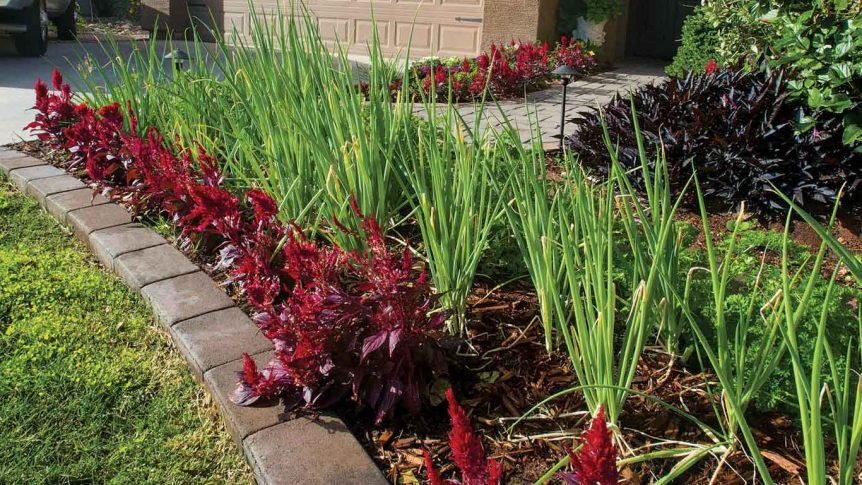Gardeners who treasure fragrance above all other sensory experiences gained through the hobby can boost their olfactory satisfaction by adding herbs to their plant lineup. In pots, amongst regular landscaping, or in their own special scent gardens, herbs can bring delight to the nose.
“Warm, still evenings are the ideal time to enjoy an herb scent garden,” says David Trinklein, University of Missouri extension horticulturist. As the sun warms their leaves throughout the day, the essential oils and other aromatic compounds produced by herbs volatilize into the air, creating a cocoon of scent for those who linger. The timing for peak enjoyment is perfect for unwinding after a long day of work. Simply head straight to the scent garden for a little aroma therapy.
Herbs equate to cooking for many. But this article will keep to herbs enjoyed for their aromatic and aesthetic appeal. Though in many cases they will be the exact same plants, it’s important to not treat herbs used in landscaping as you would herbs from a vegetable garden.
“You don’t want to use any herbs from a flower garden as a food source if they have been sprayed with a pesticide not labeled for food crops,” Trinklein warns. “Never harvest and consume herbs or edible flowers if you don’t know the cultural history of the plants.”
Fortunately, there’s plenty of enjoyment to be had from herbs beyond eating.
What Is An Herb?
Herb is short for herbaceous, which describes a vast number of plants. But the plants that have come to be known as herbs today are those that have in their tissues and excretions pungent aromatic compounds and oils that provide intense scent and taste. Despite the diversity of scent and taste, many herbs are of the mint (Lamiaceae) family. In addition to mint itself, there are basil, thyme, lavender, lemon balm, oregano, marjoram, rosemary, sage, and more, all closely related.
“Members of this family have tiny glandular hairs on their leaves that secrete essential oils that are aromatic,” Trinklein explains. Others, such as basil, have pungent compounds in their tissues or leaves.
Over the years plant breeders have worked to amplify these aromatic compounds and produce cultivars with surprising and delightful scents. Cinnamon or licorice basil, lemon thyme, chocolate mint, and many more are available for those who choose to hunt down unique varieties.
“The champions in this area are scented geraniums. There’s an entire collection of unusual scents such as apple, pineapple, chocolate, lemon, and so forth,” Trinklein says.
Simple straightforward herb varieties offer a diverse selection of scent worthy for a scent garden or to add a pop of aroma in a flowerbed as well: the earthy tones of lavender, sweet smelling basil, refreshing peppermint or spearmint, the citrusy scent of a lemon balm or a lemon monarda, the savory aroma of oregano and thyme, or the sharp smell of rosemary. All can be mixed and matched in a dedicated scent garden to delight gardeners and their guests.
Create An Experience
The warmth of the sun can amplify the perfume of herbs, but touch can have a similar effect. When the foliage of herbs is brushed up against or crushed, it releases a rush of scent for immediate enjoyment. One garden strategy taking advantage of this fact is stepping stone gardens.
In these gardens, flagstones or similar materials are laid with spaces left between. The gardener then plants an aromatic herb in those spaces so when a person walks through the garden their steps crush some of the herb’s leaves, releasing a pleasing scent.
“Lower growing herbs, such as English creeping thyme, creeping, or lemon thyme, are excellent choices for a stepping stone garden. The leaves are small and the plants are very aggressive so they can hold up to being crushed underfoot,” Trinklein says.
Pollinator Delight
Humans aren’t the only ones who enjoy a well-tended scent garden. All herbs are angiosperms, which means they’re flowering plants. Those flowers mean pollinators of all shapes and sizes will frequent the garden as well.
“Pollinators, especially the European [also known as Western] honeybee, loves plants in the mint family which encompasses a huge variety of plants you’d find in an herb scent garden,” Trinklein says. Native pollinators, butterflies and beetles are likely to drop in for a visit.
Plan for Containment
Growing herbs doesn’t require much of a green thumb. Insects don’t bother them much, they can tolerate somewhat poor soil, and they’re just generally user friendly as a garden plant, Trinklein says.
The main issue is they can do a bit too well. Herbs in the mint family especially tend to reproduce by underground roots known as rhizomes. The roots spread outward sprouting new plants as they go. It won’t take long for a lone plant to colonize a whole bed, which is fine if that’s your intention.
“Herbs are not good neighbors of other plants and need to be kept inbounds,” Trinklein says. They can be kept in check with a simple barrier. Find a pot of significant volume, such as a nursery gallon pot that measures 10 inches across and 12 inches deep. Cut the bottom off (to allow for drainage) and sink the resulting cylinder into the soil so the top of the pot is level with the surface of the soil.
“Plant the herb in the buried pot and the plastic will keep the plant from spreading past the pot’s edge. The roots of herbs tend to be very shallow, rarely reaching below 8 to 10 inches,” Trinklein says.
With a good plan for containment, head to your favorite plant supplier to seek out some favorite scents. And don’t sacrifice looks! Many herbs, such as lavender, have beautiful flowers or have been bred to have appealing variegated foliage.
Make sure your scent garden is a treat for all the senses and don’t leave all the enjoyment outdoors. Check out this guide on making garden bouquets for some more ideas for using herbs.
Helpful links:

